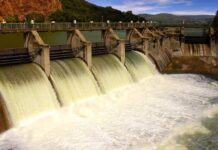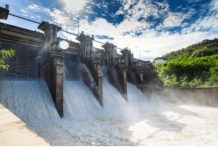The installed capacity of the plant is 1,240MW. The plant was renamed Governador Josรฉ Richa Hydroelectric Plant in February 1999.State-owned electric utility Companhia Paranaese de Energia (COPEL) is the electric utility for the Brazilian State of Paranรก, and supplies power throughout the south of Brazil. In the mid-1990s it recognised that rapid growth of electricity consumption would require it to build new capacity. It already operates a number of large hydropower stations, including four plants on the river Iguaรงu; the $1bn Salto Caxias hydropower project is downstream of these.The concession awarded to COPEL for the operating the plant will expire in 2010.
Location
The Salto Caxias hydropower project is located on the Iguaรงu river between the cities of Capitรฃo Leonidas Marques and Nova Prata do Iguaรงu in the state of Paranรก, Brazil.
The site takes advantage of a natural 180ยฐ bend in the river, where the river fell rapidly over shallow rapids. The powerhouse sits on the narrow wedge of land jutting into the river at this bend.
The river has been damned across the upstream leg of the bend with a gravity roller compacted concrete dam. The dam diverts water into four steel penstocks, each of which feeds water to a vertical-shaft Francis turbine. After passing through the turbines, the water is returned to the river in the downstream leg of the bend. The head of water created across the river bend is 50m to 68m.
Construction of the hydropower project began in January 1995. The first of the four turbines went on-line in February 1999 and the fourth and final unit entered commercial service before the end of 1999. This was a remarkably quick time to complete a $1 billion hydro project.
Gravity roller-compacted concrete dam
“The Salto Caxias dam is 1,100m long and has created a reservoir covering 180kmยฒ.”
The Salto Caxias dam is 1,100m long, 67m high, and has created a reservoir covering over 180kmยฒ. The dam is a gravity roller-compacted (RCC) type and is the eighth largest dam of its type in the world.
Intertechne Consultores Associados (IAC) carried out design and project engineering. IAC is a consortium made up by Intertechne, LEME, Engevix and Esteio Consultores Associados. In conjunction with COPEL, ICA found the RCC would be 25% less expensive than a rock-fill dam.
Conventional concrete was used to face the vertical upstream face of the dam to provide an impermeable seal. Conventional concrete was also used in layers between layers of RCC to build up steps to form the downstream side of the dam. DM Construtora de Obras Ltda carried out the civil works.
The dam has a spillway with 14 radial gates, each 16.5m wide and 20.0m high, to release water into the main river channel. The spillway can discharge almost 50,000mยณ/s. There are 15 sluiceways that feed water into the power station intake channel. The intake channel in turn feeds four carbon steel penstocks, 11m in diameter and 107m long. A consortium of BSA, Coemsa and Barefame fabricated the penstocks.
Cracks in the dam were noticed by COPEL when it filled the reservoir in late 1998. In 2005 COPEL announced it was planning to fix the cracks and that it would carry out studies to determine the cause.
Powerhouse and turbines
The powerhouse is 180m long and houses four vertical-shaft 310MW Francis turbines supplied by Kvaerner and four generators supplied by Ansaldo Coemsa. Kvaerner and Ansaldo Coemsa formed a consortium to bid for the project and were awarded the contract in December 1995. The turbines had to be designed to cope with a relatively wide variation in head of water, 50m to 68m, and the COPEL specification called for minimal cavitation at both full and partial loads.
The design chosen by Kvaerner was similar to that it had used in the Three Gorges project in China. The turbines have 7.6m-diameter X-blades which provide the best possible cavitation resistance yet still give a 91.5% operational efficiency at the design speed of 90rpm.
“The plant’s powerhouse is 180m long and houses four 310MW turbines.”
Components for the turbines were made in a number of locations and shipped to site for assembly. Forgemaster in the UK made the turbine shaft assembly, Canadian Steel Foundries and Lokomo Steel of Finland shared the manufacture of turbine blades and Alstom in France supplied the hub and band. The completed turbine runner weighed 160t. At the beginning of 1998, Beckwith sold and shipped five M-3430 Integrated Protection System relays to COPEL for Salto Caxias.
Beckwith engineers travelled to Brazil for commissioning and testing of the relays, and four relays have been put into commercial service while one is a spare.
Generators and control systems
The four synchronous generators were supplied by a consortium of ABB Brazil, Coemsa and Bardella and pre-assembled by Ansaldo Coemsa. The generators are vertically mounting synchronous type with a rated output of 845MVA at 16kV and 60Hz and a power factor of 0.90. Toshiba-Mitsui supplied the switchyard equipment and ABB Brazil supplied transformers.
ABB supplied its OCS (Open Control System) for the project. The system has 20 distributed programmable controllers connected by a fibre optic network. Each controller has specific local functions, including human machine interface (HMI), data management, analysis and storage. The plant management system includes plant history, automated reports and other functions to support operation and maintenance of the power station.
Specialised turbine and generator monitors will be interfaced with the OCS system. Bruel & Kjaer and Rittmeyer supplied the turbine monitoring system. VibroSystM supplied generator monitoring equipment. The plant will be controlled from a central control room located within the powerhouse, but full remote control from the COPEL head office in Curitiba, 100km away, is possible.
Cost
The overall project cost of $1 billion was made up of six main elements. The supply and installation of electromechanical and the civil construction work accounted for just over half the total. COPEL’s internal costs for project management, financial provision, insurance and other administrative matters accounted for a further 16%. Project consultants fees were $40 million or 4% of the projected total project cost. A further 3% was spent in providing services, temporary buildings and site management.
The remaining 25% was spread across 26 separate programmes to mitigate the social and environmental impact of the project. There was a resettlement programme for 1,000 families, owners and workers on farms in the area now covered by the reservoir. This included not only land provision but also investment in healthcare provision, construction of community centres and churches, and road building. COPEL will provide active support to the displaced communities for the first three years after their relocation. Other programmes included protection of ecosystems, environmental monitoring, and the preservation of historical artefacts from the area.












































